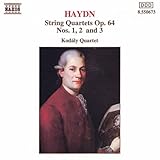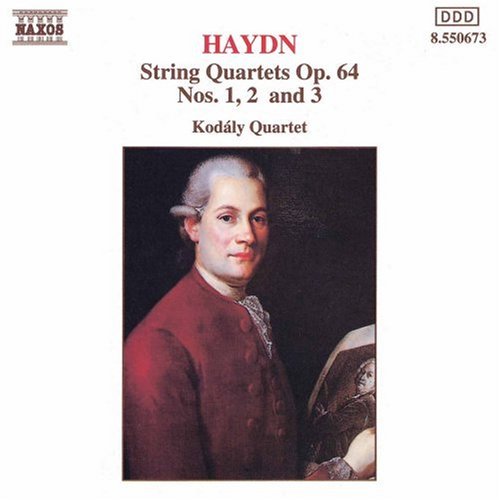Disco de Franz Joseph Haydn: «Haydn: String Quartets Op. 64, Nos. 1, 2 and 3»

- Valoración de usuarios: (4.5 de 5)
- Título:Haydn: String Quartets Op. 64, Nos. 1, 2 and 3
- Fecha de publicación:1994-02-15
- Tipo:Audio CD
- Sello discográfico:Naxos
- UPC:730099567329
- 1String Quartet In C Major, Op. 64, No. 1, Hob. III: 65: Allegro Moderato
- 2String Quartet In C Major, Op. 64, No. 1, Hob. III: 65: Menuetto: Allegretto ma non Troppo
- 3String Quartet In C Major, Op. 64, No. 1, Hob. III: 65: Allegretto Scherzando
- 4String Quartet In C Major, Op. 64, No. 1, Hob. III: 65: Finale: Presto
- 5String Quartet In B Minor, Op. 64, No. 2, Hob. III: 68: Allegro Spiritoso
- 6String Quartet In B Minor, Op. 64, No. 2, Hob. III: 68: Adagio ma non Troppo
- 7String Quartet In B Minor, Op. 64, No. 2, Hob. III: 68: Menuetto: Allegretto
- 8String Quartet In B Minor, Op. 64, No. 2, Hob. III: 68: Finale: Presto
- 9String Quartet In B Flat Major, Op. 64, No. 3, Hob. III: 67: Vivace Assai
- 10String Quartet In B Flat Major, Op. 64, No. 3, Hob. III: 67: Adagio
- 11String Quartet In B Flat Major, Op. 64, No. 3, Hob. III: 67: Menuetto: Allegretto
- 12String Quartet In B Flat Major, Op. 64, No. 3, Hob. III: 67: Finale: Allegro Con Spirito
This budget-priced CD is part of a complete recording of the Haydn string quartets performed by the Kodaly Quartet of Budapest. It includes the first three quartets in Haydn's opus 64, which consists of 6 quartets. These are rather late works and were composed in 1790, just before Haydn's first visit to London. (i.e. the time of the "London" symphonies) There is no more accessible introduction to chamber music than the Haydn quartets. This CD is a delight in its variety and in the joy of making music.
The first quartet of the set, in C major, is serene and happy in character. The first movement is an allegro moderato which opens with a bouncy theme in the solo violin which is soon taken up by the entire quartet. There is counterpoint in the minor in the development, and the recapitulation, surprisingly, is extended and varies the exposition by shifting to the minor key just before the end. This quartet lacks a slow movement. The second movement is a minuet which features a whimsical theme in the cello. The third movement is a scherzo which is angular in character and slightly faster than the minuet. It consists of a lengthy theme which is repeated and embellished twice -- almost a variation movement. The finale is marked presto and features dramatic pauses and stops and a piping theme in the violin's high register. The movement and the quartet come to a sudden, quiet ending.
Although the first quartet lacks a slow movement, this lack is more than compensated in the lovely adagios in the second and third quartets on this CD.
The second quartet is in B-minor and is somber in character. The first movement, allegro spirituoso, opens with a short violin solo followed by a dramatic turn to the minor. The movement increases in intensity as it progresses. The second movement, adagio ma non troppo, is an extended slow movement with a lyrical theme and long note values. The theme is stated in the first violin and echoed in the cello and middle strings. As the theme is developed it is elaborated with filigree in the violin and a restatement of the theme in the cello. The third movement is a minuet which returns to the minor. It features a peaceful, lyrical trio in which the violin has the lead. This theme in the trio echoes the slow movement of the quartet. The finale is marked presto and is again in the minor. The movement increases in dramatic intensity until its quiet end in the high register of the violin.
I found the third quartet in B-Flat major the most enjoyable of the three on this disk. The quartet is lively and energetic, with unusual rhythms, lots of trills, and a slow movement even more extended that that of the b-minor quartet. There is excellent contrast and continuity in the movements of this work.
The first movement, vivace assai, opens in unison with the opening theme followed by a flowing second theme stated in the violin. There are many delicious twists and turns in this movement, particularly the trills over the cello and the running themes in the violin. The second movement is marked adagio. It is a lengthy movement which opens with a slow, meditative theme followed by an intense, plaintive middle section and a return of the opening material. The minuet is lively, emphatic, and rhythmic, featuring many trilling sections in the middle and lower strings and a cello drone in the trio. The finale is lively with a short, falling, carefree figure repeated many times by the first violin. There is a contrast in this movement between quick and slow sections. There is a short slow section just before the end and then a jolly close in unison.
These quartets were written to be played by amateurs and to be enjoyed by their listeners. Even more than is the case with his symphonies, Haydn established a standard in his quartet writing that subsequent composers emulated and developed. There is much excellent music in these quartets that remains to be appreciated and discovered. This CD will reward exploration both by listeners new to chamber music and to experienced listeners.
Haydn's Opus 64 quartets are extraordinary even by his exalted standards. I cannot resist quoting H C Robbins Landon at this point. Writing of the Notturni for the King of Naples, the great scholar comments, "There is also something of that special `1790' style in this music which reaches its glorious and melancholic climax in that unique set of quartets, Opus 64. In 1790 Haydn was lonely and isolated in the summery stillness of the last season (though no-one could guess that) at Eszterhaza. His mood is mirrored in his letters to Frau von Genzinger; it is also clearly reflected in the music of the last season. Perhaps the most striking example of this summery melancholy is found in the third Notturno of the second set . . . . we seem to be with Haydn in the garden of Eszterhaza on a hot summer's afternoon, watching the slow passing of huge white clouds above the yellow and green of the castle. The Prince is in Vienna, on his last journey as it turned out; the castle is half closed and the garden is empty. A profound sadness overcomes Haydn . . . . it is a magic moment which we are all privileged to share with this lonely man who filled this music of 1790 with a special mood which he never quite recaptured after his life became so different."
Each of the six quartets in Opus 64 is a bona fide masterpiece. Better still, Opus 64 / 2 is arguably the greatest adagio that the Master ever wrote with its undulating inner voices set against the first violin's endless melody - it is a Canticle of the Sun in B Major.
Lest you think me garrulous, I will be terse: these performances by the Kodaly Quartet are superlative. They are perfectly integrated as a team and flawlessly recorded. At this ridiculous price, you should not hesitate.

